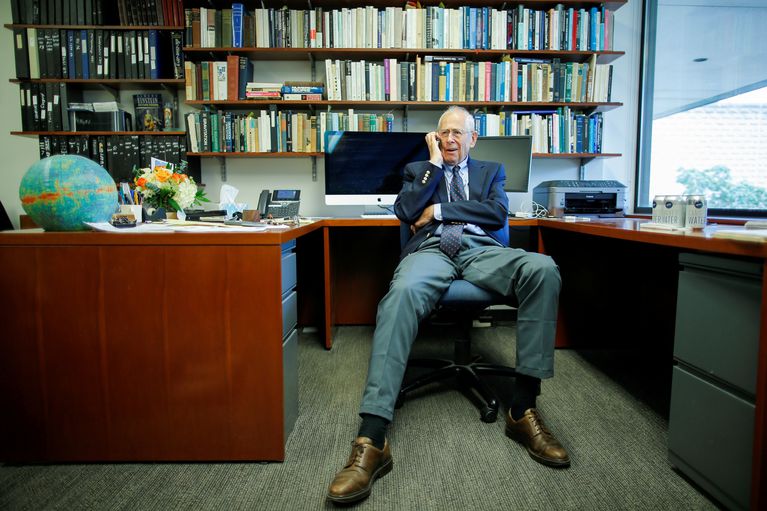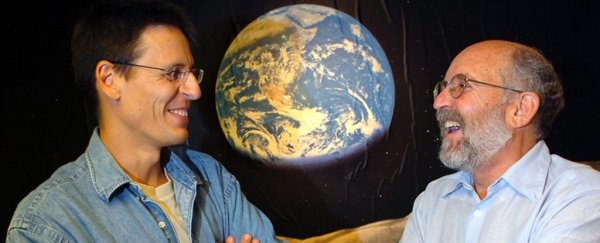A cosmologist who revealed that the universe was made mostly of invisible matter and energy, and two scientists who detected the first planet orbiting an alien star, were jointly awarded the 2019 Nobel Prize in physics Tuesday.
By studying the earliest moments after the birth of the universe, James Peebles of Princeton University developed a theoretical framework for the evolution of the cosmos that led to the understanding of dark energy and dark matter - substances that can't be observed by any scientific instruments but nonetheless make up 95 percent of the universe.
Fellow laureates Michel Mayor and Didier Queloz of the University of Geneva revolutionized astronomy, the Nobel Committee said, when in 1995 they announced the discovery of a large, gaseous world circling a star 50 light-years from our sun - the first extrasolar planet found around a sun-like star.
In the decades since, scientists have detected thousands more of these exoplanets, and astronomers now think our universe contains more planets than stars.
"This year's Nobel laureates in physics have painted a picture of a universe far stranger and more wonderful than we ever could have imagined," Ulf Danielsson, a Nobel Committee member, said at a news conference Tuesday.
"Our view of our place in the universe will never be the same again."
For almost a century, scientists have theorized that the universe began with a big bang, growing from a hot, dense particle soup into the current collection of dust, stars and galaxies flung across a vast and still-expanding space.
Fifty years ago, a pair of radio astronomers stumbled upon the signature of those earliest days of expansion: the cosmic microwave background, a faint form of radiation that suffuses the entire sky.
This radiation is a "gold mine" for physicists, the Nobel Committee said. By analyzing tiny variations in this ancient afterglow, scientists can peer back in time to understand how the universe evolved.
Peebles studied the temperature of the cosmic microwave background to understand the matter that was created in the big bang.
"It was, conceptually, a door-opening event," said observational cosmologist Sandra Faber, a staff member at University of California Observatories. "It showed that known laws of physics could explain the universe when it was only 100 seconds old. Isn't that amazing?"
Peebles also developed tools for explaining how the universe as we know it came to be. Tiny quantum fluctuations that occurred during inflation - a period of rapid expansion of the universe that unfolded in less than one-millionth of a second after the big bang - gave rise to "lumps" of matter that would eventually evolve into galaxies, he said.
These lumps, along with the still-mysterious dark matter, explain the size, shape and distribution of galaxies we see today.
"I was not working alone," Peebles said via a phone interview at the news conference Tuesday, pointing out that researchers in the Soviet Union provided important contributions to scientists' understanding of the universe's evolution.
After the detection of the cosmic microwave background in 1964, the field progressed in fits and starts, he said: "I put out lots of wrong ideas, too, you know."
Eventually, Peebles's theories led to the discovery of dark energy, the invisible force that drives the expansion of the universe, and dark matter, the unobservable material that holds galaxies together.
 James Peebles speaks to well wishers after his win. (Eduardo Munoz/Reuters/TPX Images of the Day)
James Peebles speaks to well wishers after his win. (Eduardo Munoz/Reuters/TPX Images of the Day)
Everything we can touch or see, everything ever detected by a scientific instrument, and everything that has yet to be found makes up just 5 percent of the universe. Even in that small slice of the cosmos, there is more than meets the naked eye. The science behind the second half of this year's physics prize is proof of that.
The first exoplanet observed by Mayor and Queloz wasn't visible through any telescopes. Instead, the astronomers intuited the world's existence by observing the way it affected its star.
Their research relied on the fact that planets don't orbit stars; instead, both planets and stars orbit their common center of mass. If a planet is sufficiently large, compared with its sun, it will cause the star to wobble just a bit.
This wobble produces tiny shifts in the light the star emits, and scientists can analyze these shifts to determine the size and distance of the planet.
The first world that Mayor and Queloz discovered, dubbed 51 Pegasi b, is unlike any in our solar system. The planet is large and gaseous, like Jupiter, but is so close to its star that it takes just four days to complete an orbit. Its temperature exceeds 1,000 degrees Celsius.
When Queloz first saw the planet's signature in his data, "I panicked," recalled the scientist, who was a graduate student working with Mayor at the time of the discovery. "I thought something was wrong with the instrument."
It took much reanalysis for the astronomers to convince themselves that they were looking at something real. Then they had to persuade the rest of the world. The planet was so different from what scientists predicted they would find, many researchers were initially skeptical of the discovery. But subsequent studies eventually showed that Mayor and Queloz's initial hunch was true.
"New science is very rarely done by just one person … and there were a lot people who made important contributions before and since then," said Johanna Teske, an exoplanet astronomer at Carnegie Observatories. But Mayor and Queloz's discovery "was really a turning point for the field."
Soon, astronomers across the globe were conducting their own exoplanet searches, scanning the skies and looking over reams of historical data to detect the telltale wobble of a planet-hosting sun.
Observations from ground- and space-based telescopes have revealed more than 4,000 confirmed exoplanets and challenged scientists' notions about how planetary systems evolve.
Last year, NASA launched the Transiting Exoplanet Survey Satellite, a powerful space telescope that will scan the entire sky seeking out worlds circling nearby stars. Of particular interest to the mission are rocky worlds orbiting near enough to their stars to potentially have liquid water on their surfaces.
"When [Mayor and Queloz] were studying and looking for these exoplanets, people would laugh at them … and call it science fiction," Teske said.
"To see it come from there all the way to now, where they're winning Nobel Prizes and we're getting ever closer to finding and characterizing Earthlike planets, it's great and exciting and a little surreal."
In a tradition as regular as the prizes themselves, the announcement Tuesday prompted debate over the lack of diversity among recipients. Just three women have ever been awarded the physics prize in its more than 100-year history, and no black scientist has ever been recognized.
The choice to recognize Peebles's cosmology theories sparked particular anger, because the woman who proved the existence of dark matter, Vera Rubin, was never given the award.
The Carnegie Institution astronomer battled sexism and "utterly revolutionized our concept of the universe," astronomer Emily Levesque once told Astronomy magazine. She had been considered a leading candidate for the physics prize before her death in 2016 (Nobels are not awarded posthumously).
"She was and continues to be hugely influential and inspirational for everyone in astronomy," Teske said of Rubin. "It's particularly ironic in a not-so-nice way for her not to have been recognized, and I think that will just continue to be, at least for me, a sore spot when any Nobel Prize in physics is awarded."
The Royal Swedish Academy of Sciences, which awards the prizes, told Nature last week the organization had implemented measures to address bias against women and scientists of color, including explicitly asking nominators to consider diversity in gender, geography and topic. All six recipients of this year's prizes for medicine and physics have been white men.
Yet Peebles was unique for the "intellectual interpretive stamp he put on things," Faber said. "His work ranged from the big bang to quantum mechanics to the true nature of dark matter. I am extremely happy with this prize."
The cosmologist, who worked on questions of galaxy formation and dark matter around the same time as Peebles, said his theory "profoundly affected her," emotionally as well as scientifically.
"It tells the human race that we were born according to the laws of physics and the implication is we need to live by those," she said.
Much as Peebles's research emphasized Earthlings' insignificance in the context of the universe, Mayor and Queloz's discovery revealed how rare and unusual we are. The vast majority of exoplanets discovered in the past two decades are unlike any body in our own solar system.
Still, Danielsson, the Nobel committee member, said somewhere in the vast and inscrutable universe, on one of those strange and distant worlds, it's possible that some other form of life exists.
It might take years, or centuries, or even millennia, he said. But he holds out hope that one day, hidden in the darkness, humanity will find evidence that we are not alone.
2019 © The Washington Post
This article was originally published by The Washington Post.
